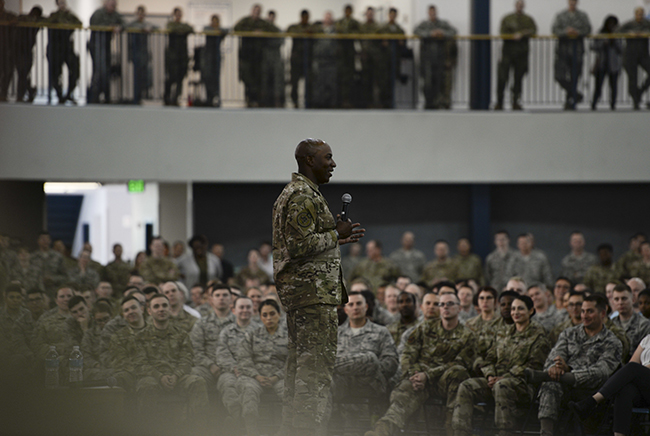
CMSAF Kaleth Wright speaks to hundreds of airmen and civilians during an all call at Baker Field House on Eielson AFB, Alaska, on June 12, 2019. Air Force photo by SrA. Kahdija Slaughter.
The number of non-deployable airmen has dropped from nearly 7 percent to less than 5 percent following last year’s Pentagon-wide mandate to “deploy or get out.”
The Air Force shrank the portion of its ranks that couldn’t deploy through a series of initiatives after former Defense Secretary Jim Mattis ordered the military to start letting go of personnel who were unable to deploy for at least a year. He pushed each service to reduce the total number of personnel who were unable to deploy.
As of December 2018, 6.8 percent of airmen—34,200 people in total—could not deploy. The biggest culprits: failing to stay current on vaccinations, addressing medical and dental issues, and falling behind on physical training.
Chief Master Sergeant of the Air Force Kaleth Wright told Air Force Magazine in a July 31 interview the figure now stands at 4.5 percent, or about 30,000 non-deployable airmen.
The service launched a push to bring personnel whose medical and other requirements had lapsed back into compliance. Mattis’s simple threat is also spurring change.
“I think a lot of people took [‘deploy or get out’] literally,” Wright said.
Mattis’s remarks reminded airmen to get their shots, prepare for a fitness test, or take care of a lingering injury to return to deployment-ready status, Wright said.
“I think that discussion of ‘deploy or get out’ drove a lot of people to say, ‘Hey, I better get right,’ because they may have feared being separated because they had been non-deployable,” Wright said.
During “all-call” meetings at multiple bases this week, Wright told airmen the service measures its readiness by tracking its airframes’ mission-capable rates and its personnel readiness. Personnel readiness following Mattis’s mandate is higher than it has been in years, he said.
The Air Force is focused on bolstering about 200 “pacing units,” or those that could be immediately sent to war, although it has not disclosed which aircraft make up those units. About 90 percent of those are ready to deploy if needed, and service leaders said in March those squadrons and their follow-on forces are on track to hit 80 percent readiness by the end of fiscal 2020. The rest of the operational squadrons are slated to reach 80 percent readiness by 2022.
In addition to his non-deployment directive, Mattis instructed the Air Force and Navy to get 80 percent of its F-35, F-22, F-16, and F/A-18 fleets combat-ready by the end of September. F-35s and F-22s are not expected to hit the 80 percent goal, and former Acting Defense Secretary Patrick Shanahan indicated it would be a stretch for F-16s as well.